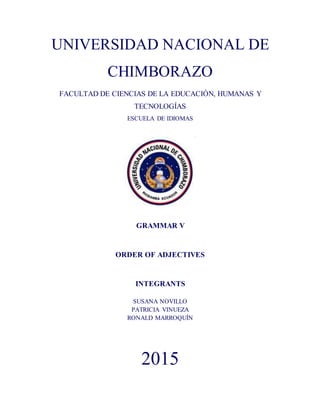Adjective order.
- 1. UNIVERSIDAD NACIONAL DE CHIMBORAZO FACULTAD DE CIENCIAS DE LA EDUCACIÃN, HUMANAS Y TECNOLOGÃAS ESCUELA DE IDIOMAS GRAMMAR V ORDER OF ADJECTIVES INTEGRANTS SUSANA NOVILLO PATRICIA VINUEZA RONALD MARROQUÃN 2015
- 2. ADJECTIVE ORDER The use of adjectives is essential when trying to describe a noun or pronoun. Good writers and speakers are able to use adjectives to create clear, mental images for the reader or listener. As you continue to work on your English, donât be afraid to use multiple adjectives to describe something. Using more than three physically descriptive type adjectives in sequence to describe one noun or pronoun would sound a little awkward. When using multiple adjectives in a sequence, you must be aware of the correct adjective order. Adjectives can be used to describe lots of things, from physical size, age, shape, colour, material, to more abstract things like opinion, origin and purpose. We can use adjectives together to give a detailed description of something. Adjectives that express opinions usually come before all others, but it can sometimes depend on what exactly you want to emphasize. For example: - "That's a nice, big, blue bag." (You like the bag.) "- That's a nice blue." (You like the colour.) When we group adjectives together there is a general (sometimes flexible) rule for the position of each type of adjective, these are:- Position 1st* 2nd* 3rd 4th 5th 6th 7th 8th Opinion Size Age Shape Colour Material Origin Purpose Nice Small Old Square Black Plastic British Racing Ugly Big New Circular Blue Cotton American Running
- 3. You might swap adjectives that express an opinion and an adjective based on fact depending on what you wish to emphasize:- For example: ï· "She had a long, ugly nose." emphasizing the length of her nose. ï· "He was a silly, little man." emphasizing that the man was silly. This is just for fun as you wouldn't normally see so many adjectives in one description. For example: ï· "She had a big, ugly, old, baggy, blue, stripy, cotton, British, knitting bag." Here are some examples: ï "The interesting, small, rectangular, blue car is parked in my space." ï "I bought a beautiful, long, red, Italian, silk tie." ï "My father lives in a lovely, gigantic, ancient, brick house." ï "I have an annoying, small, circular, American, tin, alarm clock that wakes me up." ï "Letâs order a delicious, huge, rectangular, pepperoni pizza." ï "We all love our smart, petite, British teacher." ï "They all received several dazzling, small, ancient, gold coins." ï "She owns a stunning, large, old, brown dog named Boris."
- 4. BIBLIOGRAPHY BritishCouncil.Orderof adjectives. Recuperadode: https://learnenglish.britishcouncil.org/en/english- grammar/adjectives/order-adjectives Learn EnglishGrammar,(1999-2015). EnglishAdjectives. Recuperadode: http://www.learnenglish.de/grammar/adjectiveorder.html Englishgrammar,(2015). Adjectives - Wordorder. Recuperadode: http://www.grammar.cl/english/adjectives-word-order.htm Learn English,(2009). Adjective WordOrder. Recuperadode: http://www.ecenglish.com/learnenglish/lessons/adjective-word-order



